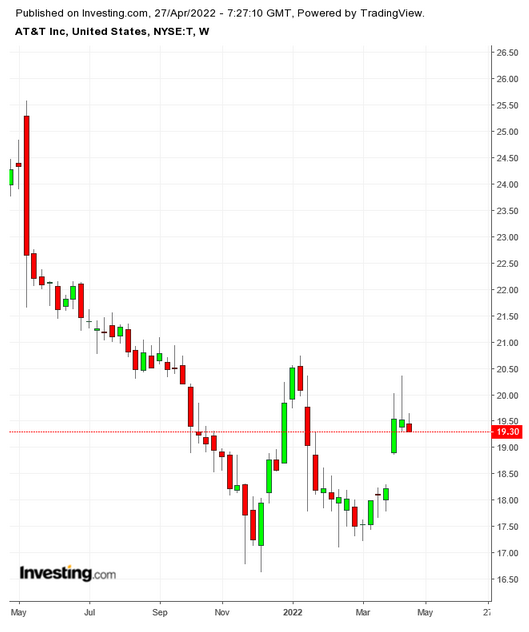For years, investors chased the juicy dividend yield offered by communications services giant AT&T (NYSE:T). It was a destructive trade.
While broad markets soared after the financial crisis, AT&T shares were dead money at best—even when the stock offered a more than 7% yield.

By November of last year, shares were at a 12-year low. Even including those hefty dividends, most shareholders wound up underwater.
Today, AT&T is a different company. It is newly slimmer after spinning off WarnerMedia to recently renamed Warner Bros Discovery (NASDAQ:WBD) earlier this month. That spin-off led to a lower dividend payout for AT&T as well.
But it still yields over 5% based on the new payout—and some investors no doubt will continue chasing that yield. They should heed the lesson that AT&T taught savvy investors over the past ten years: a dividend yield alone does not make a bull case.
There still needs to be good reason to own not just the yield, but the business—and there isn't quite enough reason to own this business yet.
AT&T Stock Fundamentals
Even setting aside the dividend—now $1.11 annually, for a current yield of 5.7%—AT&T stock still looks exceptionally cheap on a fundamental basis. With first quarter earnings last week, AT&T filed financial results on a pro forma basis. Trailing twelve-month adjusted earnings per share totaled $2.46, suggesting a price-to-earnings multiple of just 7.9x.
For this year, AT&T is guiding for free cash flow of about $16 billion. A current market capitalization of $140 billion implies a price-to-free cash flow multiple of under 9x.
The obvious question is why T stock is garnering these single-digit multiples from the market. The simple fundamental answer is that the market expects that AT&T's earnings and free cash flow might decline over time.
That expectation is far from preposterous, which is why AT&T stock is so cheap. Pro forma for the spin-off, AT&T's adjusted EBITDA declined year-over-year in 2021—though admittedly by less than one percent. Still, there's a risk that the longer-term trajectory turns negative as well.
Across the board, AT&T faces challenges. The wireless market is not growing terribly fast in terms of revenue. Competition is intense, and capital expenditures are high. Over time, consumers are likely to demand faster speeds and better coverage, yet there's not a ton of room for pricing to move higher.
Indeed, while AT&T trades around 8x trailing twelve-month earnings, wireless rival Verizon Communications (NYSE:VZ) is valued at just over 9x on the same basis. T-Mobile (NASDAQ:TMUS) garners a far higher multiple, but that company is growing more quickly and still has residual benefits to come from its acquisition of Sprint a few years ago.
Outside of wireless, there are concerns as well. The Business Wireline segment—which serves businesses with phone and Internet connections—is in long-term decline. Yet, according to figures from AT&T's 2021 annual report, Business Wireline accounted for more than 20% of EBITDA (earnings before interest, taxes, depreciation and amortization) in the Communications segment. Plus, essentially, the Communications segment is AT&T going forward.
The Consumer Wireline segment, too, is under pressure. The customer base for DSL and broadband declined in both 2019 and 2020 before rebounding modestly last year. AT&T is looking to build out its fiber business to compensate—but laying new fiber costs billions of dollars (even if the company can offset some of that spend by pulling up old copper lines at the same time).
There is a perception among some investors that AT&T stock is 'safe.' That's simply not the case.
Here's the reality: end markets offer modest revenue growth. Competition is intense. Capital spending is high.
And though the divestitures of WarnerMedia, DIRECTV, and Vrio are reducing debt, the balance sheet remains questionable. Even net of cash, AT&T still has about $130 billion in borrowings outstanding.
The combination of that kind of balance sheet leverage and declining profits can be absolutely toxic to a stock price. It's far too simplistic to assume that because T stock yields almost 6%, the stock is safe. That's the same mistake that got investors in trouble during the past decade.
The Case For—And Against—T Stock
To be fair, just because T shares aren't safe doesn't mean there's no bull case. In fact, at this point, the bull case probably is stronger than it's been in years.
The recent transactions have unwound the disastrous series of acquisitions which themselves pressured T stock. The company acquired DIRECTV in 2015—just as the 'cord-cutting' trend was accelerating amid the rise of Netflix (NASDAQ:NFLX) and other streaming services. AT&T spent $109 billion on Time Warner the following year. Yet, including debt, the current spin-off values that business at barely half the price paid.
AT&T now is simply focusing on communications—with some success. Wireless subscriber trends have improved dramatically, as management pointed out at AT&T's Analyst Day this year. The fiber business will face competition from so-called 'overbuilders,' but AT&T sees a path to success and a strong return on investment in building out that network. Obviously, the demand for data is only going to grow exponentially going forward, driving demand toward fiber as the highest-speed option, and providing long-term pricing power. Fiber growth can reverse the multi-year declines in both consumer and business wireline.
Indeed, while the market is pricing T stock for earnings and cash flow declines, management is guiding for an increase. At the Analyst Day, AT&T guided for $20 billion in free cash flow in 2023, up from this year's $16 billion. From there, even relatively stagnant operating profits can still support earnings and cash flow growth, as interest costs drop over time.
This is a leaner, potentially more nimble AT&T. That should be a good thing.
The Management Problem
There's a big stumbling block to the above case, however: management. Again, AT&T executives destroyed tens of billions of dollars in shareholder value through acquisitions.
As an activist investor pointed out, AT&T even laid the foundation for T-Mobile's growth through a failed attempt to buy that rival back in 2011. (The agreement required that AT&T give T-Mobile cash and access to spectrum if the deal fell through.)
The CEO ultimately responsible for those deals, Randall Stephenson, has departed. But the CEO now, John Stankey, was the chief strategy officer when the DIRECTV and Time Warner deals were done. After the acquisitions closed, he led both those businesses as their value eroded almost instantly.
Given industry pressures and the importance of the fiber rollout, any case for AT&T now has to rest on its management, not its dividend. And, to be blunt, it seems exceptionally difficult to entrust capital to the same company that already has destroyed so much value.
Perhaps this time is different, and perhaps an AT&T with a narrower focus will be an AT&T with stronger execution. There are some reasons, including in last week's earnings report, to believe so.
But despite a strong dividend and a conservative valuation, the road to upside here is neither straight nor simple. Execution and strategy need to be on point, and it's tough to bet on either just yet.
Disclosure: As of this writing, Vince Martin has no positions in any securities mentioned.
